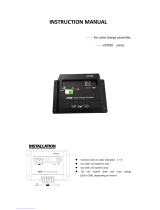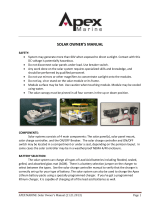
1 of the TM-2030 INSTALLATION INSTRUCTIONS.
4.3 Tools and hardware required
●Drill with bits of suitable sizes for entry of telephone cable and/or Temperature sensor into SC-2030 plastic enclosure
●Medium Phillips screwdriver for the large green terminal blocks connecting wire to panels and batteries.
●Small Phillips screwdriver for four screws holding front plate enclosure
●Wire cutters, wire strippers, and a lug crimper for the battery wire, the solar panel wire, etc.
●SC-2030 charge controller
●TM-2030 (TriMetric) battery monitor with sensing and power wires (assuming the TM-2030 will be connected)
●If TM-2030 is not yet installed, it will require an electrical shunt: 500A/50mV or 100A/100mV size. see TM-2030
installation instructions.
●Mounting hardware for the above, if required
●Wire of suitable size and length (as determined in section 4.1.6) from panels to SC-2030 and SC-2030 to batteries
● Common four wire conductor “telephone cable” up to 100 ft. long—to go from SC-2030 to TM-2030. This is the common 4
wire telephone extension cable with RJ11 connectors sold in different lengths at hardware or other stores in the telephone
accessories section. The wiring must be crossed (crossover) between the two connectors, as shown in the lower right-hand
corner of Figure 1. This is usually the way they are manufactured—but check.
●Temperature sensor (optional but recommended unless batteries will remain at same temperature)
4.4 Installing the SC-2030, connecting solar panels, batteries, and Temperature sensor
Plan to mount the SC-2030 in a well-ventilated and shaded area to prevent overheating, and protected from direct rainfall. The
heat sink can get hot during charging; therefore, the charge controller must be installed beyond the reach of animals and young
children. The black heat sink fins should be vertical—not horizontal, which means the printing of "SOLAR" or "BATTERY"
will be right side up or upside down (not sideways).
4.4.1 Run wires (size determined as described section 4.1.6) from solar panels to location for SC-2030, and from batteries to
SC-2030 location with enough extra length to easily connect to large green terminal blocks. Carefully mark on the ends of the
wire which are positive and which are negative—both to batteries and to solar panels.
4.4.2 If communication (phone) cable has RJ14 connectors attached at both ends, check that connectors are "crossed" as shown
in figure 1. Run phone cable from TM-2030 to SC-2030 location with sufficient length. If you have a RJ14 crimp tool and
correct RJ14 connector, to avoid drilling a larger hole you could pass wire through a small drilled hole through TM-2030
enclosure then use crimp tool to install connector (carefully observing polarity Fig 1). Don't yet connect the communication
cable to the TM-2030 (unless connectors at each end are attached and you don't intend to put them on or change them later.)
4.4.3 Remove front panel and circuit board from SC-2030 enclosure by removing 4 screws and put it aside. Drill one or more
holes in the SC-2030 enclosure to allow the communication cable and the temperature sensor wire (if used) to pass through in a
location suitable to the positioning of the controller, wires and the rest of the system. The temperature sense connector requires
a 5/16 diameter hole to pass through. For the communication cable, as described in 4.4.2 you could pass the wire through the
hole and attach the connector similarly to 4.4.2 if you have the appropriate connector and crimping tool. Reminder: be sure the
connectors are attached "crossed" as shown figure 1.
4.4.4 Mount the enclosure on vertical surface so the heat sink fins go up and down. Use two screws on flanges, or you may drill
your own holes internally and use those.
4.4.5 Connect the temperature sensor connector (if used) and the communication cable to the two connectors on the back of the
SC-2030 (inside the box). Place the circuit board back onto the enclosure board and secure with four screws.
4.4.6 Place the temperature sensor (if used) near the batteries. The hole in the sensor could be connected to a battery terminal—
but this is not necessary for it to measure temperature.
For safety, turn off power from batteries and solar panels before doing next step
4.4.7 Connect the wires from batteries and the solar panel wires to the controller. For the following steps, refer to wiring
diagram, Figure 1. For safety, turn all switches and circuit breakers off while making the connections. While
voltages in a 12V or 24V solar system are generally considered safe from electrical shock, amperages can be
very high and can create powerful arcs if accidentally shorted, or when connections are made or unmade.
a. Connect the SC-2030 minus wire to the batteries. Observe in figure 1 how the SHUNT is connected to the
batteries. The shunt has two large bolt terminals. One is connected to the battery negative terminal—the
other side is connected to the loads in your system. The wire from the SC-2030 “BATTERY minus” terminal
(large green) must go to the LOAD side of the shunt. Avoid a common mistake of connecting this directly to
the negative post of the battery. If you make this mistake the solar current will not register as “amps” on your




















